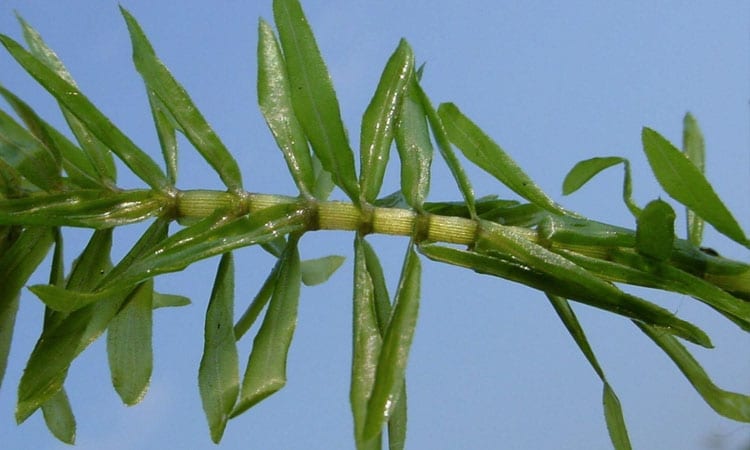Dense, rootless, bushy mats of leaves with very small serrations and white flowers on short stalks.
- English Name: Brazilian Elodea
- Latin Name: Egeria densa
- Propogate: Vegetative fragmentation
- Symptoms: Dense, bushy mats of small leaves with white flowers on short stalks.
- Dangers: Overwhelms other aquatic plants, is expensive to eradicate. It will form a monotypic stand that can become so dense that water movement is restricted. The fragmented pieces can clog water intake pipes. It will cause fluctuations in water quality, and it traps sediment.
The Brazilian Weed That Took Over American Lakes
A Brazilian Elodea is not easy to identify. Each plant is a profusion of many small leaves growing in whorls around the stem to make a leafy cylindrical bunch. It can live as a rootless plant that floats freely on water and mostly grows underwater. It can also be rooted and where they take hold, the weeds form dense mats along the surface, choking other plants and fish habitat and making it near impossible for people to swim, boat or fish.
The weeds sprouts small white flowers on thread-like stems above the water from spring to late summer.
It gets difficult to identify Brazilian Elodea because they look a lot like their American and Canadian counterparts the American waterweed and the Canadian elodea. The American waterweed, for instance, is visually different only in that it has three instead of four leaves in every whorl. The native weeds are also less of a nuisance because they are kept in check by local insects and animals.
The Brazilian Elodea is native to Brazil, Argentina and Uruguay and is common across America, particularly in Washington, Massachusetts, California, and Florida.
The Trouble with Brazilian Brazilian Elodea
Brazilian Elodea has over the years proved to be quite difficult to control. Because new plants grow from fragments, physical harvesting, for instance with rakes or mechanical implements is not very effective. Most herbicides are also limited by their chemical side effects. Read how using herbicides to treat lake weeds leads to Algae
Grass carp, especially the older insects, do much better at containing the weed, and even seem to prefer it to other plants. But the insects may not be used in water bodies that are important habitats for waterfowls or some kinds of fish, such as salmon and steelhead.
Which is why we developed the Lake Bottom Blanket, currently the only weed killer with 100% kill rate and no effect on the environment. The blanket is a specially formulated polythene sheet about 10 feet wide and as wide as the water body may require that pins down a mass of weeds to the bottom of the lake and kills them by denying them sunlight. Fish and other aquatic life are not affected because the Blanket hangs slightly above the lake bottom. It is made of material that is lighter than water and is held in place by strategically placed weights.
The Lake Bottom Blanket has already been used in over 400 lakes in over 29 states. It is patented and approved by the DNR’s and DEP’s of California, Nevada, New York, Connecticut, Massachusetts and Washington.

